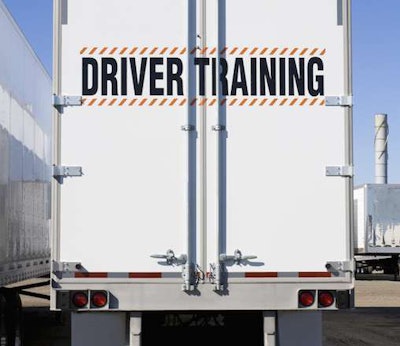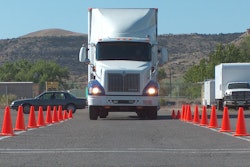
After calling bovine scat on the powers-that-be and all the wolf crying in my last blog on the “driver shortage” notion, I felt I should go further into the subject. It does absolutely no good to throw rocks at a problem and not offer solutions.
In May of 1993, I had two babies in diapers and had just been laid off from my union job. I needed to make a decision for my future, and the future of my babies. My best friend had made the pitch to me to drive truck for a living, but having two toddlers and not wanting to miss out on their development I was reluctant to jump at it. Having family in the trucking business, I knew that making that jump would mean missing birthdays, skinned knees, proms and graduations, partly because of the business and partly because of where we lived in Montana. The dispatch home, whether a self-dispatch or not, could be a tall order.
At once, I knew I could not one day look at my kids and tell them I did not do everything I could to offer them a better life. So at the end of May 1993, I went down to the DMV, took the written test and one week later climbed into the cab of a ’94 International. My buddy’s cousin stopped long enough in Billings to pick me up, and I received my first crash course in trucking.
That night he looked at me and said, “Tell me what you know about a truck?”
I got partway into it when he stopped me and said, “How do you start this truck?” At first, I looked at him, dumbfounded – Are you serious, I thought — then found the ignition switch and turned the truck on. “Good,” he said. “You would be surprised how many don’t even know how to do that.”
Then he instructed me to put the truck on the road heading west to Seattle, and as I proceeded to do so he just sat in the jump seat saying nothing. After we rolled through the scale in Laurel, Mont., he told me I was doing fine. “Wake me up when we get to the mountains.”
The next morning, as we were descending Snoqualmie Pass, he popped his head out of the sleeper and, seeing where we were, scolded me for not waking him. Yet he was pleased at my progress, and once we got to the bottom executed a rolling switch. And so began my training as an over-the-road trucker. From that day on we did not drive as trainee and trainer, but as a team. He made himself available for any questions, and occasionally would sit up with me to make sure I was doing things right. For the first couple of weeks, he was always attentive to any turning maneuvers — and while backing into parking spots or docks. He drilled into me when he was up to always watch my mirrors, keep your eyes moving, leave yourself an out and read all signs, no matter how seemingly superfluous.
After a month with him I climbed in with my buddy and it was more of the same for another two months until my truck was ready from the dealership. From day one, we ran as a team. When I asked both about it they simply said, “If you can’t do it after a month you never will.”
Their main criteria seemed to be that I didn’t fall asleep at the wheel: “Let’s go trucking!”
Once I climbed into my own truck in a lease-purchase deal, the next year entailed an expensive learning curve. I made bad decisions that put me in tough situations, tore up the extensions on my tractor, blew a rim and a wheel on my trailer, and picked up a ticket or two along the way. With each expensive mistake I learned what not to do. Only by the grace of God did I make it through my first five years without killing myself or someone else to still make money.
I say all this because for decades OOIDA has pushed for set rules on driver training. Yet when the FMCSA finally gets it done it is more of a joke than a real improvement. In fact, what’s in place and slowly being implemented in the Entry Level Driver Training rule is more akin in my mind to what you might expect for drivers who have had previous experience but for one reason or another stepped away from trucking for a while, then returned. The required training gives the trainee no clear indication of whether he or she is really ready for what trucking will throw at them.
Yes, I have heard the arguments – that after obtaining a CDL, freight companies will step in and do the finishing work needed to properly train new drivers. Some, maybe. But I see permissions granted to a variety of large fleets to allow drivers who’ve passed the CDL skills test but don’t yet physically possess their CDLs to drive team with no restrictions as in a certain way ensuring that the kind of on-the-job pre-CDL training I received will be the rule of the day.
If companies really want to fix their driver retention issues, offer free and thorough training for pre-CDL training. Not just a grand total of 50 hours. One of the reasons OOIDA has pushed so hard for rules was to get rid of these fly-by-night two- and three-day schools promising a CDL but offering no real training, simply test-passing information.
Secondly, give recruits time to adapt in finishing programs: six months ought to be a minimum and should include winter driving. Eight months would be better. Two of those months should be driving with a trainer in the jump seat at all times. Then, if they wish to run the truck as a team — fine, but six to eight months should give the student plenty of time to figure out if they can adapt to the lifestyle, and the trainer enough time to know if they can meet job requirements.
Yes, this would probably take longer in most programs. The trainer should continue as a mentor for as long as the student needs it. After 20 years, I’m not afraid to admit that I am still learning, and still asking questions. However, if carriers and regulators approached training as if it was something to be serious about instead of a joke, it is a sure bet accident rates would drop, and fewer students would quit the life altogether.










